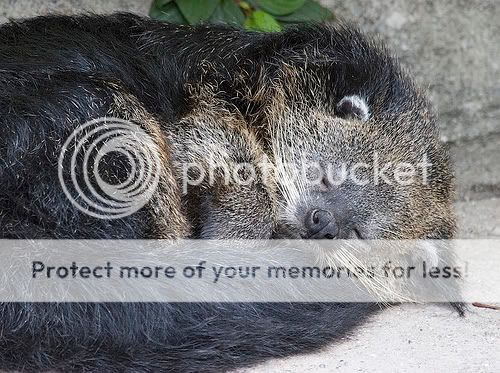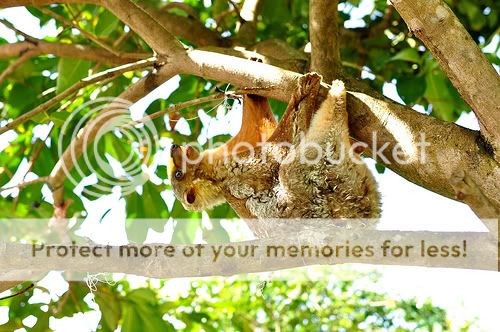Colugo #1 :Philippine Flying Lemur
Com.name: Philippine Flying Lemur , Kagwang, Colugo
Sci.name: Cynocephalus volans
Classification: Mammals
Family: Colugos (this animal is not a true lemur)
Location/Origin:
The Philippine Flying Lemur is endemic to the Philippines. Its population is concentrated in the Mindanao region and Bohol
status: Least Concern
Description:
An average Philippine Flying Lemur weighs about 1 to 1.7 kilograms and is 14 to 17 inches long. It has a wide head, small ears and big eyes. Its clawed feet are large and webbed for fast climbing and for gliding. Its 12-inch tail is connected to the forelimbs via a patagium. This membrane helps it glide distances of 100 meters or more, useful for finding food and escaping predators such as the Philippine Eagle. Its 34 teeth resembles that of a carnivore but the Philippine Flying Lemur eats mainly fruits, flowers and leaves. It is nocturnal and stays in hollow trees or cling on dense foliage during daytime. The female Philippine Flying Lemur usually gives birth to one young after a two-month gestation period. The young is helpless and attaches itself to its mother's belly, in a pouch fashioned from the mother's skin flaps. The Philippine Flying Lemur is arboreal and usually reside in primary and secondary forests.
However, some wander into coconut, banana and rubber plantations. They are considered as pests since they eat fruits and flowers and are hunted down by humans. Its flesh is also cooked as a delicacy and its fur is used as material for native caps
Reference:
Philippine Flying Lemur - Wikipedia, the free encyclopedia
Results 121 to 130 of 541
-
01-08-2010, 08:10 PM #121
-
01-08-2010, 08:10 PM #122
Fowl #1 : Palawan Peacock-pheasant

Com.name: Palawan Peacock-pheasant, Napoleon Peacock-pheasant
Sci.name: Polyplectron napoleonis
Classification:Birds
Family:Fowls-Pheasants
Location/Origin: Endemic to the Philippines, the Palawan Peacock-pheasant is found in the humid forests of Palawan Island in the southern part of the Philippine archipelago.
status: Vulnerable
Description:
The male is the handsomest and most peacock-like member of the genus Polyplectron. It has an erectile crest, a white stripe over the eyes and highlyiridescent metallic green and black plumage. The tail feathers are decorated with large blue-green ocelli, which may be spread fanlike in courtship displays. The female is smaller than the male. It has a dark brown plumage with a short crest and is whitish on the throat, cheeks and eyebrows
Reference:
Palawan Peacock-pheasant - Wikipedia, the free encyclopedia
Civet #2 : Palawan Bear Cat

Com.name: Binturong
Sci.name: Arctictis binturong whitei
Classification: Mammals
Family: Civets
Location/Origin:
Its natural habitat is forest canopy, and it spends most of its time in the trees of southeast Asia, Borneo, Vietnam, Malaysia, Indonesia and Palawan Island.
status: The Palawan binturong is vulnerable
Description:
They are nocturnal and sleep on branches. Their bushy tails are fully prehensile and act as a fifth hand. They are about the size of a large house cat, averaging about 60–95 cm (24–37 in) and 9-14 kg (20–31 lb). The tail is nearly as long as the body with size ranging from 55–90 cm. The ears are small and rounded and it has small eyes. They have coarse and thick black fur. They eat primarily fruit, but also have been known to dine on eggs, shoots and leaves, and small animals including rodents and birds. Deforestation has greatly reduced their numbers. When cornered, a Bearcat can be vicious. A Binturong can also make chuckling sounds when it seems to be happy. Binturongs can live over 20 years in captivity. One is recorded to have lived almost 26 years.
The female binturong has a pseudo-peinis, or "false peinis", a rare feature found only in a few other mammals such as the hyenas.
They are nocturnal and sleep on branches. Their bushy tails are fully prehensile and act as a fifth hand. They are about the size of a large house cat, averaging about 60–95 cm (24–37 in) and 9-14 kg (20–31 lb). The tail is nearly as long as the body with size ranging from 55–90 cm. The ears are small and rounded and it has small eyes. They have coarse and thick black fur. They eat primarily fruit, but also have been known to dine on eggs, shoots and leaves, and small animals including rodents and birds. Deforestation has greatly reduced their numbers. When cornered, a Bearcat can be vicious. A Binturong can also make chuckling sounds when it seems to be happy. Binturongs can live over 20 years in captivity. One is recorded to have lived almost 26 years.
Binturongs climb trees and leap from branch to branch, using their tails and claws to cling while searching for fruit, eggs, leaves, birds, and rats. They can rotate their hind legs backwards so that their claws still have grip when climbing down a tree head first. Binturongs also use their tails to communicate, through the scent gland located under it. The scent of Binturong musk is often compared to that of warm popcorn and cornbread. Binturongs brush their tails against trees and howl to announce their presence to fellow Binturongs. Slow and graceful, the Binturong hunts in the night and sleeps during the day. The Orang Asli of Malaysia keep bearcats as pets.
Reference:
Binturong: Serenity on Flickr - Photo Sharing!
Binturong - Wikipedia, the free encyclopedia
-
01-08-2010, 08:43 PM #123
Passerine #4 : Chestnut Munia

Com.name: Black-headed Munia, maya pula , red maya, maya sa palay
Sci.name: Lonchura atricapilla atricapilla
Classification:Birds
Family:Passerines
Location/Origin:
Found in Bangladesh, Brunei, Cambodia, China,India, Indonesia, Laos, Malaysia, Burma, Nepal, Philippines, Singapore, Taiwan,Thailand, & Vietnam.
Description:
The Black-headed Munia, Lonchura atricapilla (formerly considered as a subspecies of the Tricoloured Munia Lonchura malacca atricapilla) also known as Chestnut Munia, is a small passerine bird. Known as maya pula ("red maya", to distinguish it from the predominantly brownish Eurasian Tree Sparrow which is also called maya) in the Philippines, this bird was the former national bird of the Philippines (the Philippine national bird is now the Philippine eagle).
Reference:
Black-headed Munia - Wikipedia, the free encyclopedia
-
01-08-2010, 08:59 PM #124
Passerine #5 : Eurasian Tree Sparrow

Com.name: Maya, house bird, langgam, sparrow,gorion
Sci.name: Passer montanus
Classification: Birds
Family: Passerine-Sparrows
Location/Origin:
This sparrow breeds over most of temperate Eurasia and Southeast Asia
Description:
The Eurasian Tree Sparrow, is a passerine bird in the sparrow family with a rich chestnut crown and nape, and a black patch on each pure white cheek. The sexes are similarly plumaged, and young birds are a duller version of the adult.
The legend tells that Maya birds are best kept free because caging them shortened their lives. Mayas were compared to the freedom loving spirit of Filipinos who, in spite of being frail and small in size, fought fiercely their invaders to attain their freedom. A patriotic song, "Bayan Ko", used this bird as a reference to the burning sentiments of incarcerated and oppressed Filipinos during wars or simple struggles
Reference:
Eurasian Tree Sparrow - Wikipedia, the free encyclopedia
Solitude and Freedom on Flickr - Photo Sharing!
-
01-09-2010, 10:20 AM #125
GOoD mOrning~ New posts SooN
-
01-09-2010, 10:22 AM #126
Recorded so far:
Mammals:
Deer #1 Visayan Spotted Dear
Primate #1 Philippine tarsier
Civet #1 Asian Palm Civet
Civet #2 Palawan Bear Cat
Pig #1 Visayan Warty Pig
Bat #1 Giant golden-crowned flying-fox
Bat #2 Large Flying Fox
Colugo #1 Philippine Flying Lemur
Reptile:
Crocodile #1 Philippine Crocodile
Crocodile #2 Estuarine Crocodile
Agamid #1 Philippine Sail-Fin Lizard
Skink #1 Philippine Crocodile Skink
Gecko #1 Tokay Gecko
Gecko #1 Common House Gecko
Monitor #1 Gray's Monitor
Monitor #2 South-East Asian Water Monitor
Monitor #3 Panay Monitor
Snake #1 Philippine Palm Viper
Snake #2 Wagler's Pit Viper
Snake #3 Philippine Cobra
Snake #4 Sunbeam Snake
Snake #5 Reticulated Python
Snake #6 Striped Bronzeback Tree Snake
Bird:
Raptor #1 Philippine Eagle
Raptor #2 Philippine Serpent Eagle
Raptor #3 Philippine Scops Owl
Raptor #4 Philippine Hawk Owl
Raptor #5 Australasian Grass Owl
Raptor #6 Brahminy Kite
Raptor #7 Philippine Eagle Owl
Passerine #1 Cebu Flower-pecker
Passerine #2 Visayan Flower-pecker
Passerine #3 Asian Glossy Starling
Passerine #4 Chestnut munia
Passerine #5 Eurasian Tree Sparrow
Fowl #1 Palawan Peacock Pheasant
Hornbills-Toucans #1 Philippine Rufous Hornbill
Invertebrates:
Scorpion #1 Dwarf Wood Scorpion
Scorpion #2 Lesser Brown Scorpion
Page 1:Philippine Crocodile, Philippine Sail-fin lizard, Philippine croc skink, Philippine Eagle, Visayan Spotted dear, Dwarf Wood Scorpion, Tokay Gecko-
Page 2: Philippine Serpent Eagle,Lesser Brown Scorpion, Philippine Tarsier, Cebu Flowerpecker-
Page 3: Philippine Owls,Philippine Rufous Hornbill , Visayan FLowerpecker, Asian Civet-
Page 4: Monitor Lizards In the Philippines-
Page 5: Visayan Warty Pig, Philippine Palm Viper-
Page 6: Philippine Flying Foxes/Fruit bats, Brahminy Kite, Philippine Eagle Owl-
Page 7: Asian Glossy Starling,Wagler's Pit Viper,Philippine Cobra, Tiki, Sunbeam snake,reticulated python-
Page 8: Manlulukay, Estuarine Croc-
Page 9: Kagwang,P.P.Pheasant,P.Bearcat, maya, gorion-
-
01-09-2010, 03:51 PM #127
ON HOLD~
Barred Honey Buzzard
Jerdon's Baza
Philippine Cockatoo
Philippine Hawk Eagle
Tamaraw
Tamumukaw
-
01-09-2010, 04:22 PM #128
Raptor #8 : Barred Honey-buzzard

Com.name: Barred Honey-buzzard
Sci.name: Pernis celebensis
Classification:Birds
Family:Raptors
Location/Origin:
It is found in Indonesia and the Philippines
status: Least Concern
Description:
Its natural habitats are subtropical or tropical moist lowland forests and subtropical or tropical moist montane forests.
Reference:
Barred Honey-buzzard - Wikipedia, the free encyclopedia
-
01-09-2010, 04:23 PM #129
Raptor #9 : Jerdon's Baza

Com.name: Jerdon's Baza
Sci.name: Aviceda jerdoni
Classification: Birds
Family:Raptors
Location/Origin:
It is found in South-east Asia
Description:
Jerdon's Baza (Aviceda jerdoni) is a moderate sized brown hawk with a thin white-tipped black crest usually held erect.
It is about 46 cm long. It is confusable with Crested Goshawk or the Crested Hawk-eagle in flight, but can be distinguished by the longer upright crest, very broad and rounded paddle-shaped wings and mostly plain and pale underparts. It has a white chin and a bold black mesial stripe. The bird is typically seen in pairs making aerial sallies; crest held erect. Occasionally, the birds may be seen in small family parties of 3 to 5 seen in flight near edge of forests. The birds indulge in 'soaring and undulating' display flights near the nest. Breeding season varies locally but the bird is known to breed almost the entire year with the exception of a few months around April and May. Food includes lizards, grasshoppers and other large insects. The stomach contents of a specimen collected in present day Kurseong included agamid lizard, Japalura variegata, several longicorn beetles and mantises.
Reference:
Jerdon's Baza - Wikipedia, the free encyclopedia
-
01-10-2010, 06:22 PM #130
Advertisement
Similar Threads |
|






 Reply With Quote
Reply With Quote


